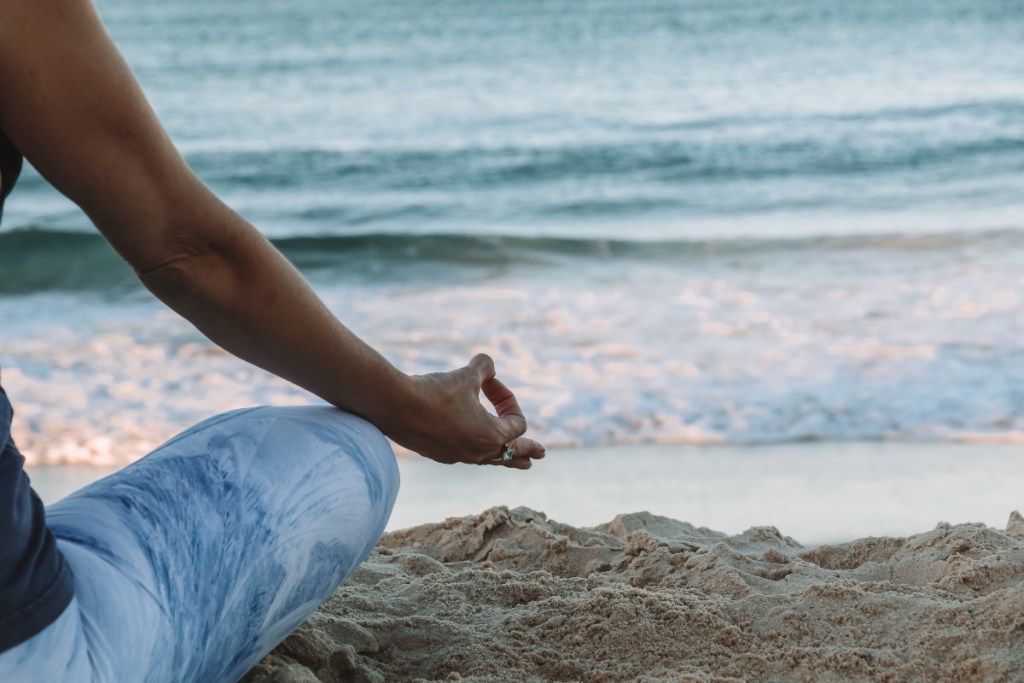Yoga is one of the most relaxing activities you could add to your daily routine. During practice, you focus intently on your breathing and movements and paying close attention to keeping proper form can be a welcome distraction from life’s daily stressors.
Though going into a studio where an instructor is available to provide individual feedback, it can be less expensive and time-consuming to work on your flow from the comfort of your own home. Services like YouTube and Amazon Prime have thousands of classes aimed at bona fide yogis and beginners alike, so there’s virtually no barrier to entry.
If you don’t have time for a whole 30 minute or hour-long class, try to spend a few minutes sinking into these four relaxing yoga poses.

Happy Baby
This gentle and easy pose serves as a hip opener, making it especially beneficial for runners and cyclists who may be prone to tightness in their groin areas.
- Lie on your back with your legs outstretched and hands by your sides. Gaze up at the ceiling.
- Exhale. Bend both knees and pull them in towards your chest, keeping your knees at a 90-degree angle. The soles of your feet should face upward.
- As you inhale, grab the outsides of your feet with your hands. Using your hands, pull your feet out slightly so they are a bit wider than your hips. Then, pull them up towards your armpits.
- Flex your heels into the palms of your hands. Gently rock your body from side to side for several breaths.
Plank Pose
This core-strengthening pose stabilizes your spine, and though the burn may be a little uncomfortable, it is a great method to destress. With so much attention spent on holding the plank, your mind will wander far from whatever is bugging you. Just remember to breathe through the pose. For a modified option, let your knees rest on the ground.
- Place your arms on the floor directly under your shoulders. Your wrists and shoulders should be in one line.
- Ground your toes into the floor, keeping your legs straight but not locked. Squeeze your glutes and core to maintain stability.
- Keep your body, from your head to your toes, in one line. Don’t arch your back upwards or downwards — it could cause stiffness later. Focus your gaze on one spot on the floor and breathe normally through the pose. Hold for at least seconds.
Hands and Knees Balance
Like the plank, this relaxing pose isn’t without its challenges.
- Begin in a tabletop position with wrists a touch in front of your shoulders. Keep a slight bend in the elbows and ensure your knees and hips are in a straight line. Inhale.
- On an exhalation, draw your belly button into your spine.
- Inhale and extend your right hand straight in front of you and your left leg behind you. Pretend you are trying to touch one end of the room with your right hand and the other with your left leg. Ground the left hand and right knee into the floor for support.
- Hold for five breaths.
- Slowly lower the hand and leg.
- Repeat on the opposite side.
- Repeat at least five times.
Savasana Pose
The hallmark closing pose of any yoga practice, Savasana or corpse pose, encourages meditation and inner peace.
- Lie on the floor with feet hip-width apart.
- Relax arms down by your side with palms facing up. Roll shoulders back and away from your ears to remove tension in the upper body.
- Close your eyes. Breathe.
- Stay here as long as you’d like.
Yoga is one of the most inexpensive and effective methods of stress relief — you can do anything from a few poses to a full practice from the comfort of your living room. If you’re in search of a quick way to calm down and release some tension, dedicate a few minutes to focus on these relaxing poses, and temporarily put your other stresses on the backburner. Find what works for you, and don’t forget to take what you learn on the mat into your everyday life: Breathe during challenging moments and focus on the task at hand.




